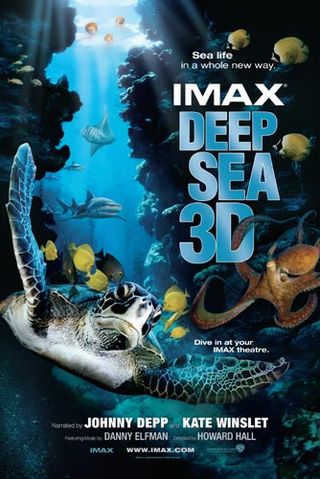New IMAX Film Brings Deep Sea to Life

Cozying up to sharks and eels is much more attractive in "Deep Sea 3D," where you can watch them from the comfort of a theater without worrying about winding up as dinner.
The undersea documentary (40 minutes, Not Rated) opens in IMAX theaters nationwide today. It gives even the most landlocked viewer an up-close look—enhanced by three-dimensional glasses—at diverse ocean wildlife with the added benefit of staying dry.
The tenuous balance between predator, prey and symbiotic relationships between sea creatures, be they hungry octopi, unflappable mantis shrimp, or sea turtles looking for a shell wash, forms the heart of director Howard Hall's ("Into the Deep") "Deep Sea 3D."
Actors Johnny Depp and Kate Winslet narrate this all too brief—40 minutes—glimpse of the living creatures beneath the sea and the destructive effects of humanity on their environment. Unlike James Cameron's "Aliens of the Deep," also an IMAX 3D film, "Deep Sea 3D" focuses on the interactions of its sea creatures and not merely their strangeness.
Despite its brevity, the movie displays a wide assortment of aquatic fauna. Giant manta rays glide in serene circles searching for food, while a plucky shrimp fends off an impending attack from an antagonistic octopus. A Humboldt squid offer an undersea light show with their color-changing skin. Green sea turtles take advantage of algae-eating fish to scrub their shells clean at the ocean floor.
Filmmakers caught coral spawning en masse in an event timed to occur one hour after sunset eight days past the full August moon. And in a rather ghoulish bit, a Wolf eel chomps on a spiky sea urchin with gusto.
Danny Elfman's orchestral score lends energy to the film as it guides the production across its many locales. Hall and his filmmaking team skirted three hurricanes as they moved from the Sea of Cortez (Hurricane Javier) to the Gulf of Mexico (Hurricane Katrina) to record the images for the IMAX documentary. Three minutes of footage could take two hours or more, the filmmakers said.
Sign up for the Live Science daily newsletter now
Get the world’s most fascinating discoveries delivered straight to your inbox.
About the only failing is the lack of more examples of how humans have contaminated or destroyed once-lush seascapes. Especially when the protection and wonder of the ocean is, at the end of the day, the point of the picture.
- Sewage and Intersex Fish
- Beach Pollution Worse During Full Moon
- Silver Contaminates 'Pristine' North Pacific
- Ship Noise Drowns Out Whale Talk, a Threat to Mating
- Acid Buildup in Oceans Threatens Food Chain
- Five Deep-Sea Fish on Brink of Extinction
Movie Numbers
Number of undersea locales: 9
Total unique sea animal species filmed: 67
Longest dive: 4 hours, 30 minutes
Most threatening encounter: 14-foot Tiger Shark
Total film shot: 73 miles
Number of hurricanes affecting film: 3

Tariq is the editor-in-chief of Live Science's sister site Space.com. He joined the team in 2001 as a staff writer, and later editor, focusing on human spaceflight, exploration and space science. Before joining Space.com, Tariq was a staff reporter for The Los Angeles Times, covering education and city beats in La Habra, Fullerton and Huntington Beach. He is also an Eagle Scout (yes, he has the Space Exploration merit badge) and went to Space Camp four times. He has journalism degrees from the University of Southern California and New York University.
